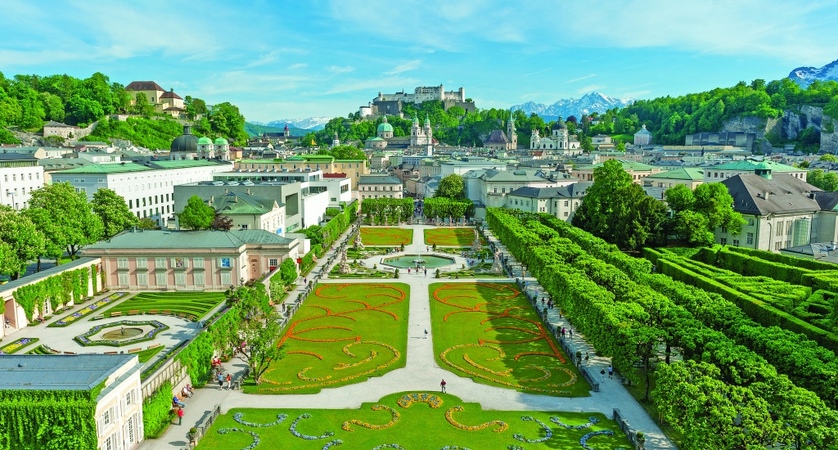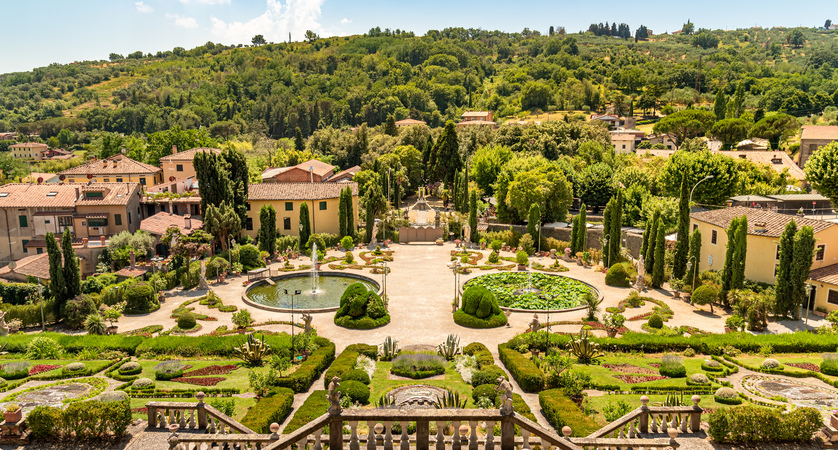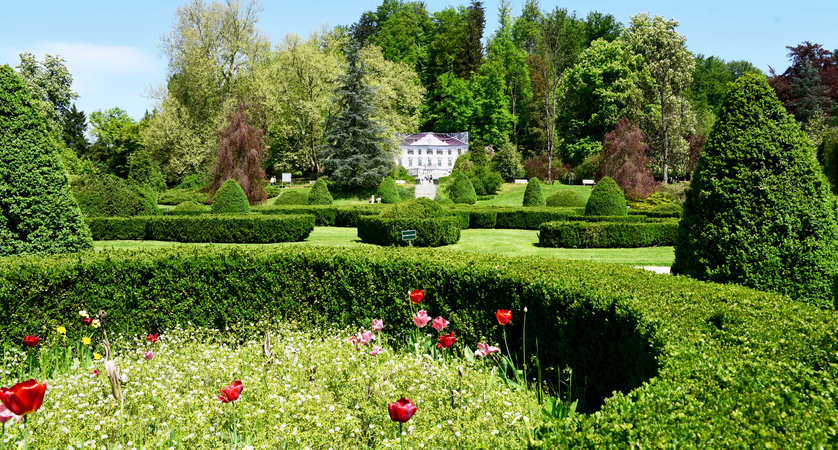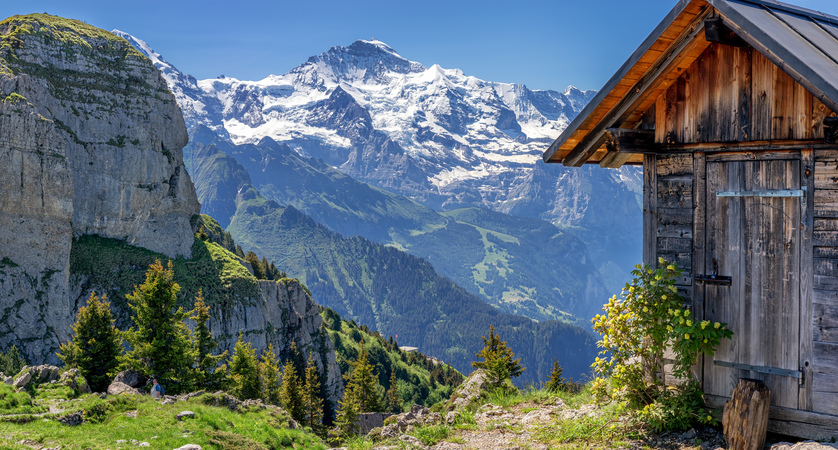If you enjoy all things bright and beautiful, then you'll love this Insider Guide on our favourite gardens around Europe. Take a look at our tips on how you can get outdoors and bring the best of the Alpine region into your own garden and home.
Mirabell Gardens in Salzburg, Austria

History
Fans of The Sound of Music will be familiar with the famous Mirabell Gardens, and some of the iconic scenes filmed there. Why not re-enact the famous Do-Re-Mi scene at home by hopping up and down on your garden steps pretending it's a piano! The Hedge Theatre isn't just famous because Julie Andrew's danced her way through it; it is also one of the oldest hedge theatres north of the Alps. These gardens were opened in 1854 by Emperor Franz Joseph and they have been recognised worldwide as a horticultural masterpiece ever since. Salzburg also plays host to the Water Gardens at Hellbrunn Palace which is renowned for its trick fountains. When the palace was built in 1612, water was always intended to be a definitive feature of the residence, mainly to provide entertainment.
What's in the garden?
The gardens are believed to be so magnificent due to unique features such as the Dwarf Garden, or Zwerglgarten. These are quirky marble sculptures believed to be modelled on entertainers and servants of Archbishop Franz Anton Harrach, who created the garden in 1715. In spring time, the Mirabell Gardens mainly plant forget-me-nots, pansies, wallflowers and bellis sylvestris, which is basically a daisy. Between mid- and late May, all of the flowers are switched out for summer flowers, they are mainly begonias, geraniums, marigolds and zinnias.
Be inspired - maximise your space
Place colourful plants like forget-me-nots, pansies and bellis sylvestris (daisies) in spiral patterns just like those in the Mirabell Gardens. Perfect for maximising space, spiral flower beds are easy to do, all you need are sticks or tape to mark out the edges of your pattern. Spiral flower beds can come in two forms, either flat to the ground or you can build the flower beds up vertically to maxamise your space and create a feature. If you choose to build vertically, you don't even need a patch of ground, as they can be built on top of patios, pavement and rooftops. By building up vertically, you create more growing space, make watering easy, and lessen the need to bend over whilst harvesting. Another great tip to maximise space in your garden is to increase the size of your flower beds and reduce your lawn into a pathway that flows between each area.
Isola Bella and Isola Madre in Lake Maggiore, Italy

Lake Maggiore is a haven for garden lovers. There are two beautiful garden islands, Isola Bella and Isola Madra.
History
Isola Bella (previously known as Isola Inferiore) was mainly populated by a small community of fishermen. It wasn't until 1630 that the aristocratic Borromeo family transformed this rocky island into something truly magnificent. By shipping in soil, the sons of Carlo Borromeo were able to begin working with architects on the gardens and they were finally completed in 1671. Isola Madre, measuring 220m wide and 330m long, is the biggest of the islands in Lake Maggiore.
What's in the garden?
The Isola Bella garden features a spectacular open air theatre and the unicorn at the top of the hill, which is the symbol of the Borromeo family. In Spring time camellias, rhododendrons, and azaleas are spread across 10 terraces along with many beautiful statues. Isola Madre island is mainly occupied by the fairytale botanical garden which is blessed with a micro-climate. Here wisteria, rare sub-tropical plants, exotic flowers and colourful birds can be found.
Be inspired-add some Italian style to your garden
Bring some colour into your garden, with mismatched pots filled with geraniums or herbs. To add an Italian focal point place statues between evergreen shrubs or surround your patio with citrus trees. Citrus trees love the warmer climates, so you can keep the tree indoors during the winter months and move outside into direct sunlight in the summer months. If you're looking for an extra challenge why not add a pergola for climbing roses?
Villa Garzoni in Montecatini, Italy

History
The Villa Garzoni is located on the Tuscan hillside near Montecatini and was the birthplace of Carlo Lorenzini, the author of the beloved children's tale, Pinocchio. We tell no lies when we say that the Garzoni Garden is one of the most beautiful gardens in Italy! The gardens took a staggering 170 years to create and construct and are famous for their ornate features, water fountains and statues. Building into the hillside, these flowerbeds and waterfalls concertina down the hill to the bottom where the gardens open up to show stunning statues and other features.
What's in the garden?
Seasonal flowers bloom in the lower beds, roses line some of the paths and there are box hedges and palm trees. At the high point of the garden, above the water staircase, there's a large pool with a fountain above it and a collection of 19th century camellias. Magical parts of the garden include the labyrinth and butterfly house which contains hundreds of different and exotic butterfly species.
Be Inspired-bring a taste of Italy to your home
Use Tuscan-style planting with symmetrical layouts and try geometric shaped flower beds. Or you could try shaping your evergreen shrubs into square or cone-shapes, to add extra shape and height. If you are short on space, an indoor herb garden is a great way to add Italian flavour to your cooking, all you need is seeds or young herb plants, soil, a bit of water and a sunny spot. We recommend starting with these three very popular herbs used in many Italian dishes. Remember, herbs are sturdy plants and only require a little bit of attention. Take care not to over water and follow these top tips:
Oregano - this herb likes to spread out, so it's best to plant it alone and keep it away from your other herbs.
Basil - make sure you pinch the flowers off this plant to allow more leaves to grow.
Rosemary - likes warmth and craves six to eight hours of sun a day, it can be sensitive in colder or warm temperatures.
Ljubljana Botanical Gardens, University of Ljubljana, Slovenia

History
The Botanical Gardens at the University of Ljubljana are world famous. Established in 1810, they are renowned for being the oldest cultural, scientific and educational gardens that the country has to offer. Thanks to the country's climate, they offer an array of stunning gardens to enjoy.
What's in the garden?
The gardens hold more than 4,500 different species and subspecies of flora, some of which are considered endangered and in need of preservation. In amongst these beautiful gardens there is an arboretum, tropical glasshouse, water-gardens and a Mediterranean area. The gardens are now officially part of the University of Ljubljana, what an amazing setting to relax in between lectures!
Be inspired - add a touch of the tropics to your home
The focal point of this Slovenian garden is its large tropical greenhouse. The real show stoppers here are the Orchids. Orchids crave warmer temperatures, so this is a plant we can all enjoy in our homes rather than our gardens. Be prepared to pamper your Orchid a little more than other plants, but we promise it will be worth it when you see your beautiful Orchid bloom. Make sure you follow these top tips: Avoid over-watering Give your orchid bright but indirect sunlight Mist the foilage With a little more time on our hands maybe now is a good time to test your gardening skills and your patience!
Schynige Platte Botanical Alpine Garden, Bernese Oberland, Switzerland

History
The garden took only one year to create. Construction work began in 1928 and the area was fenced off. The following year in 1929, the gardens opened their gates to the public.
What's in the garden?
Accessed by the scenic mountain railway, the garden sits just shy of 2,000m. There are over 600 native species of Swiss Alpine wild flowers to see and, in particular, this garden focuses on the research of high altitude flora. Graced with the monumental backdrop of the Eiger, Jungfrau and Mönch mountains, the Schynige Platte Botanical Alpine Garden is a stunning and unique wild garden that encourages you to climb, walk, clamber around and explore.
Be Inspired - embrace the wild in your garden
Take some inspiration from the wild flowers in the Swiss mountains and try sectioning off part of your garden to let nature do its thing. It's fascinating to watch the different wild flowers bloom throughout the year. Here is just some of the British flora you might find in your garden.
Dog rose a little herbal medicine for you. This flower blooms from May to July, given its name in 19th century as it was thought it could treat the bite of a rabid dog.
Honeysuckle - one for the superstitious folk out there. This flower blooms from June to September and apparently if you plant this at the front of your house then it will prevent witches from entering the home!
Forget-me-not - how could we? This flower blooms from April to June, this unique name comes from the German romantic tragedy, where a man falls into a fast flowing river while on a stroll with his lover. While being swept away he throws a bouquet of these flowers at her, shouting, forget me not!



